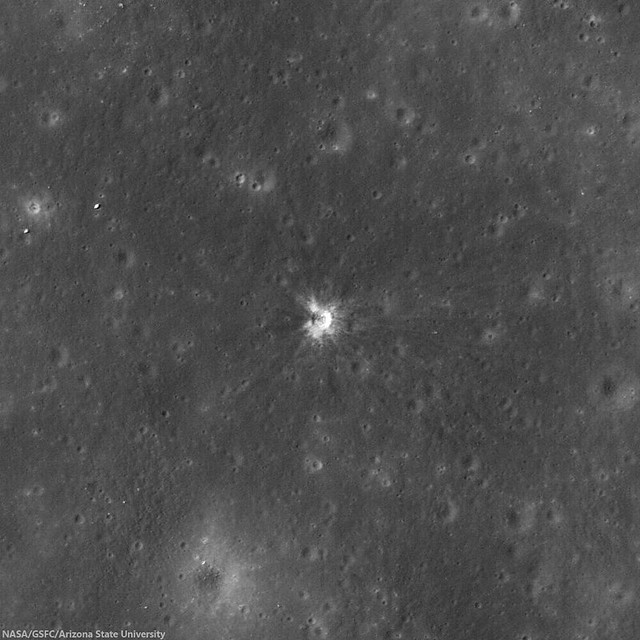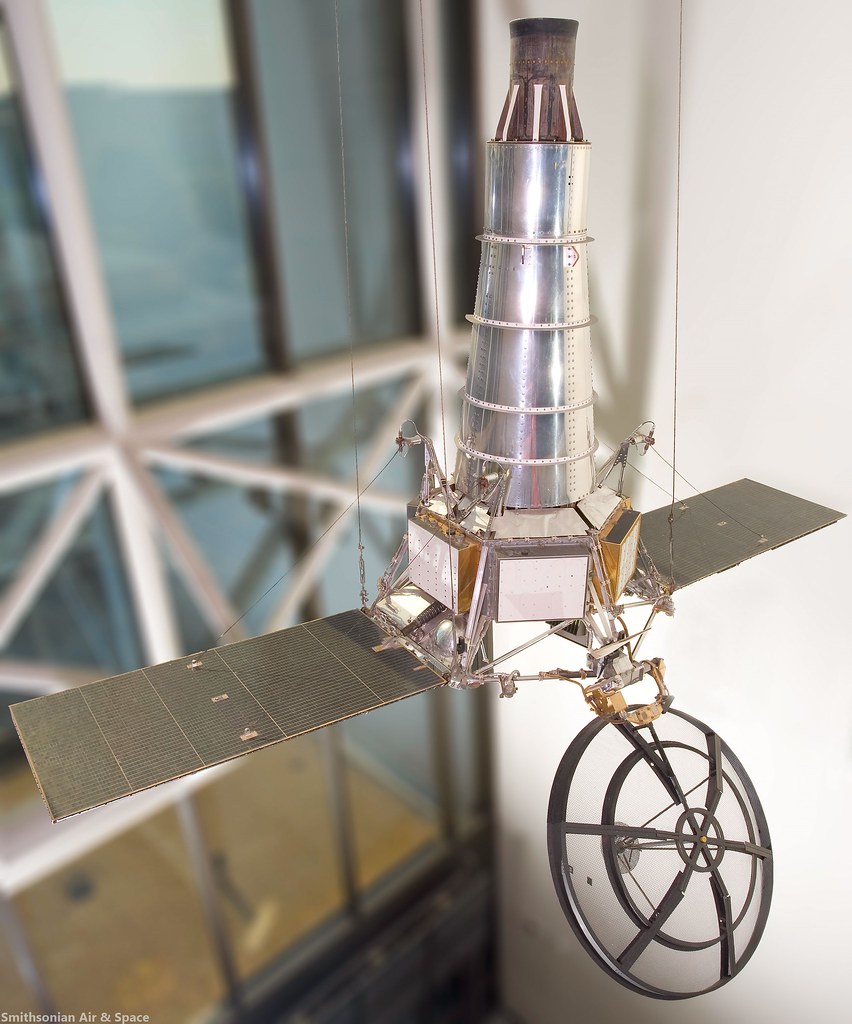Andrew J. LaPage
The Space Review
With the successful landing of the Chinese Chang’e-3 lunar spacecraft on December 14, 2013, and the subsequent deployment of its Yutu rover, the Western press has been filled with claims of how the Chinese are catching up with the American space program. Usually overlooked by these writers is the fact that these Chinese successes would have been almost impossible without the pioneering efforts (and many painful failures) of the American and Soviet lunar programs a half a century earlier.
NASA’s earliest Pioneer lunar probes, a program started by the military and inherited by the agency after it was founded in October 1958, were plagued by a series of launch vehicle failures (see “The Pioneer lunar orbiters: a forgotten failure”, The Space Review, December 13, 2010). Out of all of NASA’s initial attempts to launch probes towards the Moon, only the tiny six-kilogram (13-pound) Pioneer 4 built by the Jet Propulsion Laboratory (JPL) and launched on March 3, 1959, by a team at the Army Ballistic Missile Agency (ABMA) headed by Wernher von Braun (which would become the basis of NASA’s Marshall Space Flight Center) managed to escape Earth’s gravitational grasp to make a very distant flyby of the Moon.
The initial flights of NASA’s first in-house lunar program, Ranger, which was built and managed by JPL, fared little better than the Pioneers. The two flights of the Block I Ranger, which were designed to test the innovative Ranger design in extended Earth orbit, were stranded in short-lived low Earth orbits due to failures of the upper stage of the Atlas-Agena B launch vehicle (see “Ranger: Voyage to the Moon and beyond”, The Space Review, August 22, 2011). The three Block II Ranger flights, which were designed to hard-land a small probe on the lunar surface, fared little better. While most of the launch vehicle issues were resolved, fatal malfunctions of key spacecraft components resulted in complete failure of all of these missions (see “The Difficult Road to the Moon”, The Space Review, January 23, 2012).
As 1962 was drawing to a close, the situation with the American Moon program looked bleak. The failure of the last Block II Ranger, Ranger 5 launched on October 16, 1962, was NASA’s sixth consecutive lunar mission failure in three years. Only 17 months after President John F. Kennedy committed the United States to landing a man on the Moon with Project Apollo, it was beginning to look as though the Americans would never make it. If NASA could not get a simple unmanned probe to the Moon in working order, how could they hope to pull off the much more complicated mission of a manned lunar landing?
The Space Review
With the successful landing of the Chinese Chang’e-3 lunar spacecraft on December 14, 2013, and the subsequent deployment of its Yutu rover, the Western press has been filled with claims of how the Chinese are catching up with the American space program. Usually overlooked by these writers is the fact that these Chinese successes would have been almost impossible without the pioneering efforts (and many painful failures) of the American and Soviet lunar programs a half a century earlier.
NASA’s earliest Pioneer lunar probes, a program started by the military and inherited by the agency after it was founded in October 1958, were plagued by a series of launch vehicle failures (see “The Pioneer lunar orbiters: a forgotten failure”, The Space Review, December 13, 2010). Out of all of NASA’s initial attempts to launch probes towards the Moon, only the tiny six-kilogram (13-pound) Pioneer 4 built by the Jet Propulsion Laboratory (JPL) and launched on March 3, 1959, by a team at the Army Ballistic Missile Agency (ABMA) headed by Wernher von Braun (which would become the basis of NASA’s Marshall Space Flight Center) managed to escape Earth’s gravitational grasp to make a very distant flyby of the Moon.
The initial flights of NASA’s first in-house lunar program, Ranger, which was built and managed by JPL, fared little better than the Pioneers. The two flights of the Block I Ranger, which were designed to test the innovative Ranger design in extended Earth orbit, were stranded in short-lived low Earth orbits due to failures of the upper stage of the Atlas-Agena B launch vehicle (see “Ranger: Voyage to the Moon and beyond”, The Space Review, August 22, 2011). The three Block II Ranger flights, which were designed to hard-land a small probe on the lunar surface, fared little better. While most of the launch vehicle issues were resolved, fatal malfunctions of key spacecraft components resulted in complete failure of all of these missions (see “The Difficult Road to the Moon”, The Space Review, January 23, 2012).
 |
| Impact site of Ranger 7, a 14 meter-wide crater near the center of Mare Cognitum (10.634°S, 20.677°W). 487 meter-wide field of view from LROC Narrow Angle Camera (NAC) observation M153014430L, LRO orbit 7693, February 22, 2011; 33.97° angle of incidence, resolution 49 centimeters per pixel from 42.69 km [NASA/GSFC/Arizona State University]. |
Read the full article at The Space Review, HERE.
Related Posts:
Ranger 7: Making an Impact on History (November 7, 2013)
LROC Coordinates of Robotic Spacecraft 2013 Update (September 25, 2013)
Surveyor Crater, Before and After (July 9, 2013)
Graves of the GRAIL twins (March 19, 2013)
48 years of memories of Alphonsus and Ranger 9 (January 24, 2013)
Ranger 8 impact on digitized LOIRP image (July 31, 2012)
The discarded extension of the Ranger program (April 30, 2012)
"Boy, that sure looks like Luna 9!" (December 3, 2011)
Apollo 13 S-IVB Impact in Apollo seismic recordings (March 22, 2010)
The LCROSS 'Smoking Gun' (November 13, 2009)
LCROSS confirms water on the Moon (November 13, 2009)
When bombing the Moon was a good idea (October 21, 2009)
Apollo 14 S-IVB Impact Crater (October 8, 2009)
Surveyor Crater, Before and After (July 9, 2013)
Graves of the GRAIL twins (March 19, 2013)
48 years of memories of Alphonsus and Ranger 9 (January 24, 2013)
Ranger 8 impact on digitized LOIRP image (July 31, 2012)
The discarded extension of the Ranger program (April 30, 2012)
"Boy, that sure looks like Luna 9!" (December 3, 2011)
Apollo 13 S-IVB Impact in Apollo seismic recordings (March 22, 2010)
The LCROSS 'Smoking Gun' (November 13, 2009)
LCROSS confirms water on the Moon (November 13, 2009)
When bombing the Moon was a good idea (October 21, 2009)
Apollo 14 S-IVB Impact Crater (October 8, 2009)


No comments:
Post a Comment